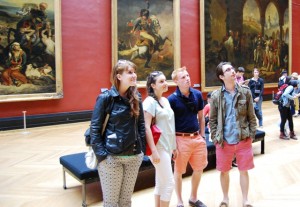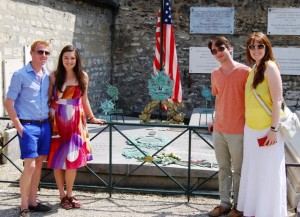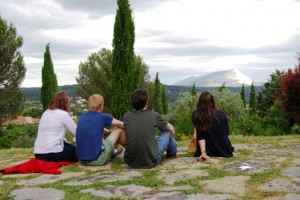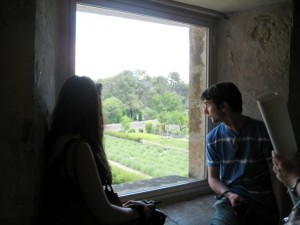Elisabeth Day ’14 (Greenwich, Conn.) tried to play it cool in Paris, but there were moments when she just couldn’t help herself. She audibly gasped before some of the world’s most famous paintings and monuments.

Briana Howard ’14, l-r, Elisabeth Day ’14, Will Rockafellow ’14, and Mark Tajzler ’14 in the grand gallery of French painting at the Louvre in Paris
Day spent two weeks this summer studying the art and culture of France through the College’s Rothkopf Scholars program along with art and economics double major Briana Howard ’14 (Saugus, Mass.), art major Will Rockafellow ’14 (Rosemont, Pa.), and art and English double major Mark Tajzler ’14 (Wilmington, Del.).
“Seeing a beautiful painting in a book is great, but seeing the original is unreal,” says Day, a double major in art and English. “The Eiffel Tower, Géricault’s Raft of Medusa, Monet’s Water Lilies, Cézanne’s studio—there were so many incredible parts to this trip. Writing and pictures don’t do it justice; it was that amazing.”
Viewing art in context is one of the most important and perspective-altering aspects of studying abroad, says Robert Mattison, Metzgar Professor of Art. He led the group and crafted an itinerary full of not only museums, but also studios, cafés, and the urban neighborhoods that influenced the artists they studied. His goal was to enable his students to experience what the artists experienced.

Will Rockafellow ’14, l-r, Elisabeth Day ’14, Mark Tajzler ’14, and Briana Howard ’14 at the grave of the Marquis de Lafayette in Picpus Cemetery in Paris
“Art history is about original objects, so seeing art on a screen disembodies it because it is not to scale and not in its proper location,” explains Mattison, who previously led a Rothkopf Scholars trip to Vienna. “There were profound interactions among artists, writers, intellectuals, and patrons that are essential to understanding the history of the era. When the students are there, going to the cafés and artists’ studios, it really brings that history to life and provides a context. I can’t think of another undergraduate-level program like this one that allows the professor to work so closely on site with a very small group of elite students.”
In Provence, for example, the group visited the mental institution where Vincent van Gogh spent a year of his life. Tajzler describes the juxtaposition of the one-of-a-kind Provençal landscape with the Roman ruins of Saint-Rémy-de-Provence located a short 10-minute walk from the institution as “otherworldly.” Combining her love of art and coffee at the Parisian café that inspired van Gogh’s Night Café was “a moment of perfection” for Day. After hiking from Paul Cézanne’s studio, Howard understood his fascination with the view of Mont Sainte-Victoire and “could have sat there all day just to watch the clouds and sun move over it.”
The group visited prominent museums in Paris—the Musée Carnalavet, Musée d’Orsay, Musée de Louvre, Musée de l’Orangerie, Musée Rodin, Centré Pompidou, and Musée Marmottan—and the Musée Granet, Musée Reattu, and Musée Calvet in Aix and Avignon. They also visited important historical sites and monuments—the Cathedral of Notre Dame, Luxembourg Gardens, Pantheon, Opera Garnier, Arc de Triomphe, Eiffel Tower, grave of the Marquis de Lafayette, Cathedral of Ste. Trophime, and the Roman baths.

The students at Cezanne’s painting spot in Aix en Provence overlooking Montagne Sainte-Victoire
Recreating the artists’ lives took them to Les Deux Magots, a coffeehouse favored by Pablo Picasso, Ernest Hemingway, Jean-Paul Sartre, Simone de Bouvoir, and Albert Camus; and Les Deux Garçons on the Cours Mirabeau in Aix where Cézanne and Emil Zola first met, Picasso’s favorite bistro. The group agreed one of the highlights was the scenic cruise along the Seine their last night in Paris.
Day, who is interning this summer at Glamour magazine and previously interned at Rokeby Gallery while studying abroad in London, was taken by the small collection at the Musée de l’Orangerie and easily could have spent extra time there. Monet’s largest and definitive works from his Water Lilies series occupy its first two rooms and stretch floor-to-ceiling and wall-to-wall.
For Tajzler, who is spending the summer in Venice through the Save Venice Scholars program, seeing the work in person completely changed the way he thought about the art. After having to crane his neck to take in A Burial at Ornans, he appreciated one of his favorite artists, Gustave Courbet, even more as a revolutionary for depicting peasants on such a monumental scale. He found a sense of realism in van Gogh’s palette after experiencing the vibrant, sun-drenched landscape of Provence. The d’Orsay’s impressive collection of works by mid- to late-19th century artists such as Courbet, Édouard Manet, Edgar Degas, and James McNeill Whistler made it one of Tajzler’s favorite stops.

Elisabeth Day ’14 and Mark Tajzler ’14 look out the window of Van Gogh’s room in the Saint-Paul de Mausole sanitarium in Saint-Remy, France. Van Gogh painted “Starry Night” from this window.
“I’d liken the experience to that of seeing a celebrity,” he explains. “When your initial understanding of the object is only through the reproduced image and discussion, the concept of the object tends to overtake the object itself, so seeing the actual work can feel quite alien. It’s an experience in breaking the fourth wall.”
At the Centré Pompidou, Howard was able to stand so close to monumental works by Picasso and Henri Matisse that she could see cracks in the paint and individual brushstrokes. She also discovered new artists in its modern art collection.
“Sometimes, I would see a piece and become overwhelmed with excitement,” she says. “It is a completely different feeling standing in front of something you spent hours studying on a little piece of paper and then, seeing it in person, you are dwarfed by a gigantic painting that you feel you know almost nothing about.”
The Rothkopf Scholars program is funded by an endowment established through gifts made to the Lafayette Leadership Campaign in honor of former Lafayette President Arthur J. Rothkopf ’55 and Barbara Sarnoff Rothkopf.



